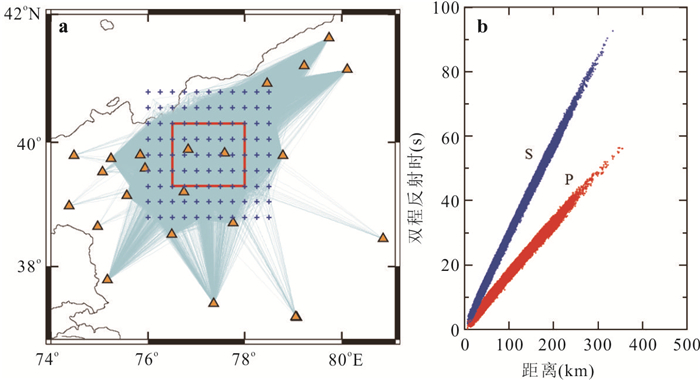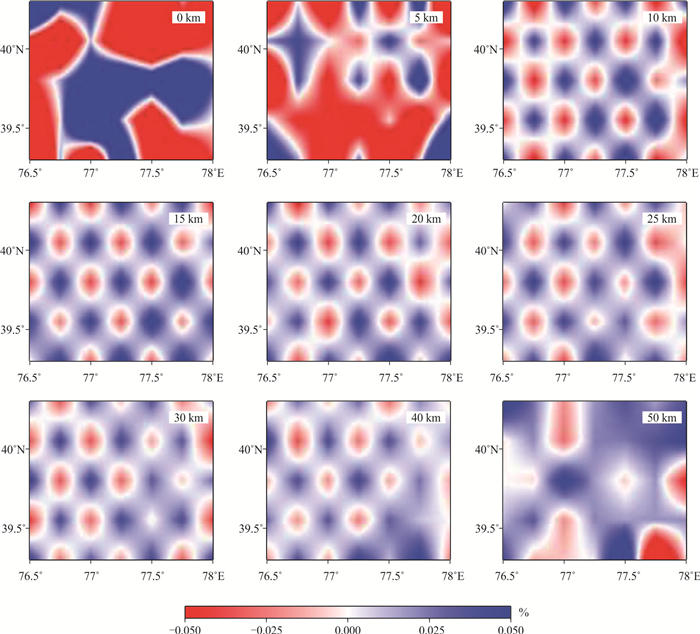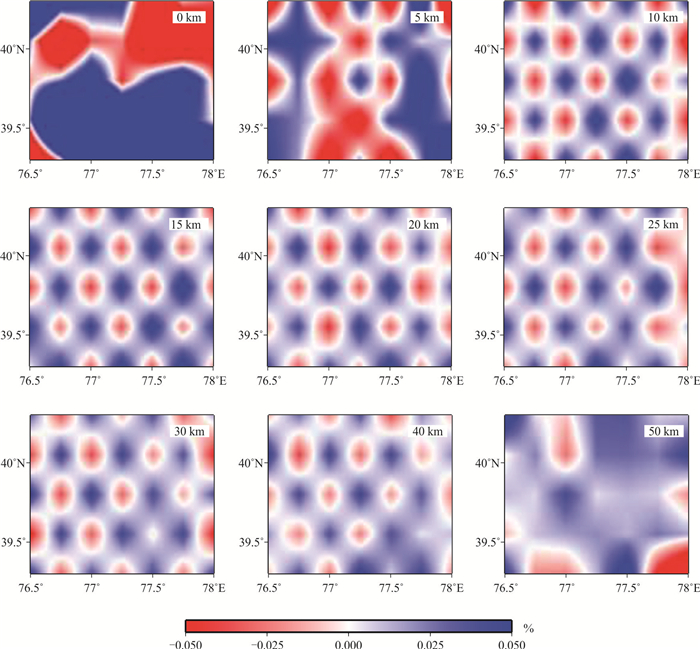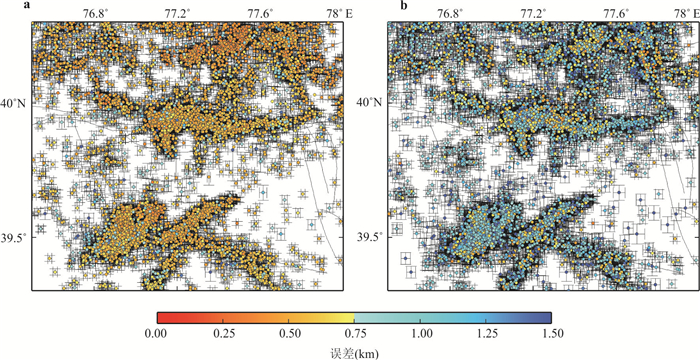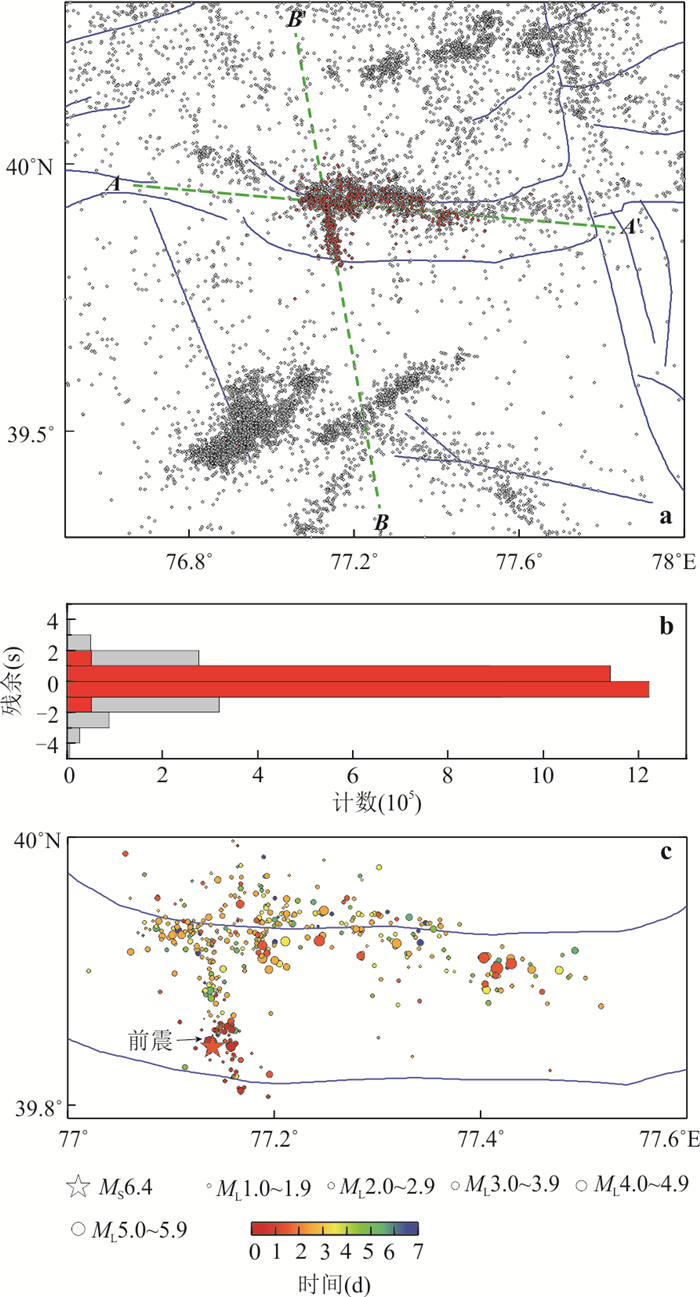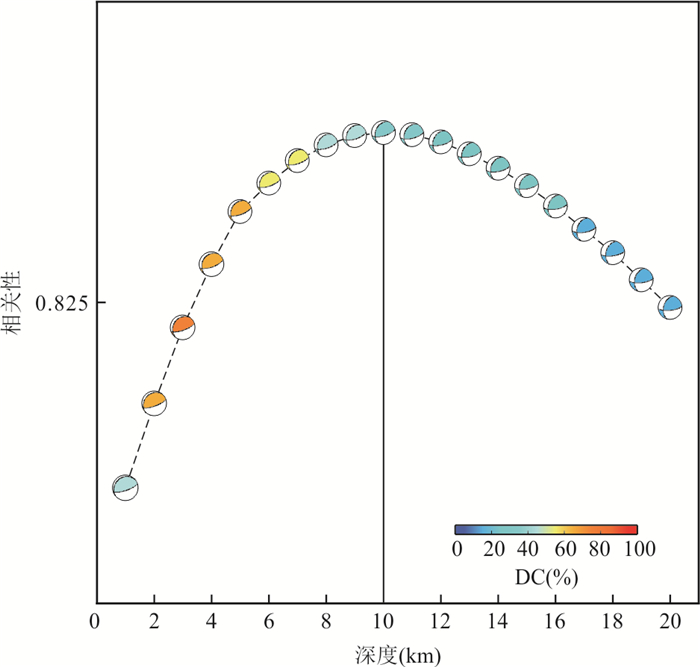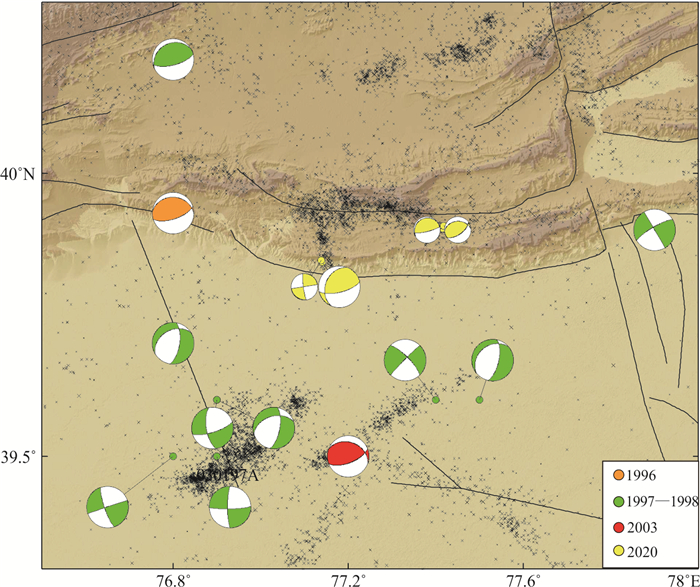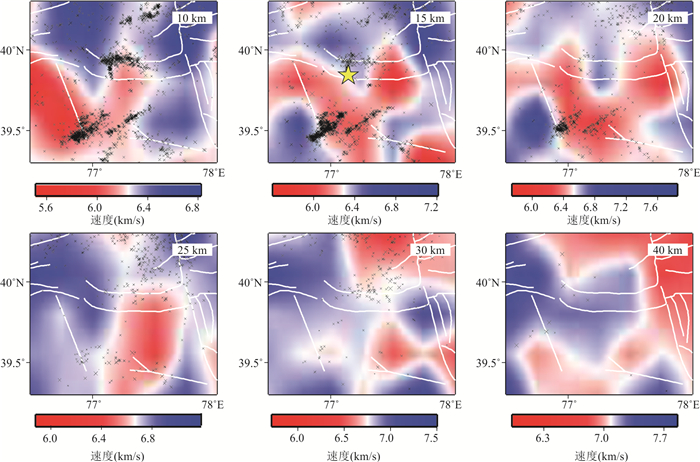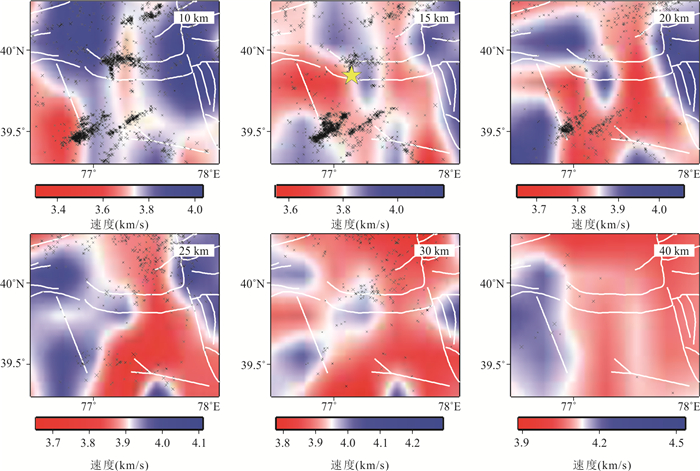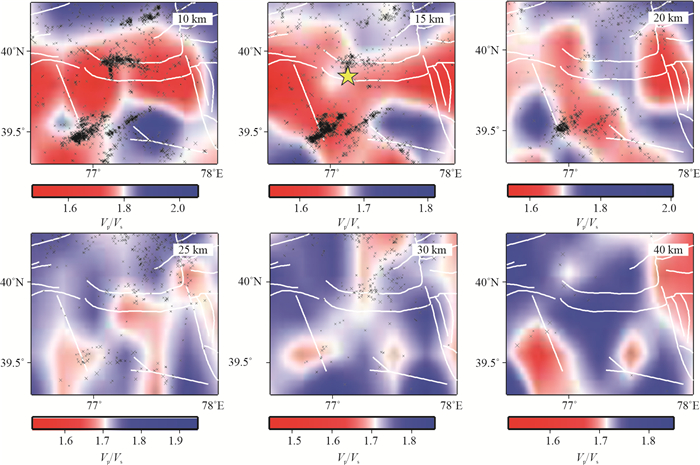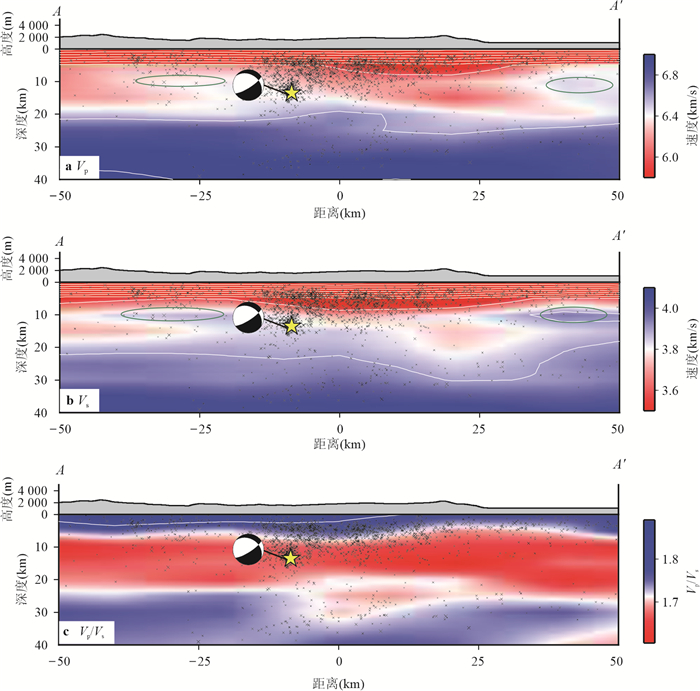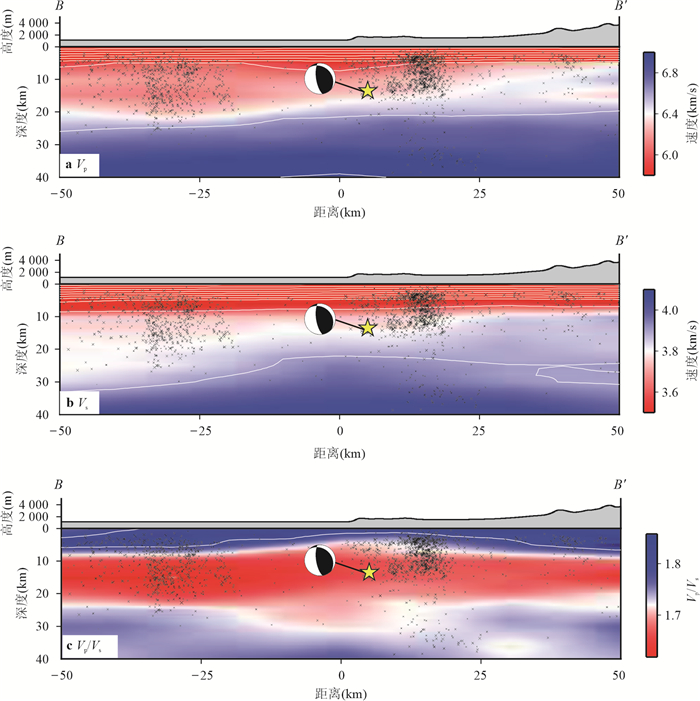Regional Seismogenic Environment Revealed by the 3D Crustal Velocity Structure and Focal Mechanism of Moderate and Strong Earthquakes in Jiashi Area, Xinjiang, China
-
摘要: 为了详细探讨伽师震区上地壳精细速度结构与地震活动的关系,基于新疆数字地震台网提供的震相观测报告和宽频带波形数据,使用双差层析成像方法获得了伽师地区(76.5°E~78.0°E,39.3°N~40.3°N)2009年以来地震精定位结果和较高分辨率的三维VP、VS和VP/VS结构,并分析了2020年伽师MS6.4地震序列中MS≥5.0地震的全矩张量解,综合研究区域内地震时空分布特征、震源机制和速度结构等信息,探讨伽师震源区发震构造及孕震环境. 结果表明,研究区重定位后的地震分布与已知断裂相关性差. 2020年伽师MS6.4地震序列呈NNW和近EW向2个优势方向分布,其余震在震后48 h内主要在距主震约20 km处近EW向的奥兹格尔他乌断裂上及其附近展布;序列中4次中强地震全矩张量解显示出具有明显的非双力偶成分,均为体积缩小的压性破裂;伽师地区地壳速度结构存在明显的不均匀性:2020年伽师MS6.4地震震中位于P波高速体内、S波高速体边缘及低波速比区域,且在中下地壳存在大范围的S波低速异常. 结合周边地质构造及前人研究结果,我们认为,2020年MS6.4主震的发震构造为柯坪塔格推覆体中的近EW向隐伏逆断裂,与其共轭的NNW向隐伏断裂也参与了整个伽师MS6.4地震序列的发震过程. 伽师地区强震频发是塔里木盆地向南天山持续俯冲挤压,触发推覆构造和盆山交界处若干隐伏断裂活动的构造运动结果,速度结构所揭示的介质横向不均匀性也造成震源破裂机制的多样性.Abstract: In order to discuss in detail the relationship between the fine velocity structure of the upper crust and seismic activity in the Jiashi area, this paper used the double⁃difference tomography method to obtain the earthquakes precise relocation results and high⁃resolution three⁃dimensional VP and VS velocity structuresin the Jiashi region(76.5°E⁃78.0°E, 39.3°N⁃40.3°N)with the seismic phase observation and broadband waveform provided by the Xinjiang Digital Seismic Network since 2009. The full moment tensor solutions of earthquakes with MS≥ 5.0 in the 2020 MS6.4 Jiashi earthquake sequence arecalculated, and the spatiotemporal distribution characteristics of earthquakes in this region are comprehensively studied.Theresults indicate that the earthquake distribution after relocation in this area has a poor correlation with distribution of the known faults. The 2020 MS6.4 Jiashi earthquake sequence was distributed in two dominant striking direction: NNW and near EW. The aftershocks were mainly distributed on and near the Ozgertau fault with near EW⁃striking, about 20km away from the mainshock, within 48 hours after the earthquake. The full moment tensor solutions of the four moderately strong earthquakes in the sequence show significant non double⁃couple components, all of which are compressive fractures with reduced volume. The results show that there is obvious heterogeneity in the crustal velocity structure in the Jiashiarea., the epicenter of the 2020 MS6.4 Jiashi earthquake is located within high P⁃velocity zones, the margin of hightS⁃velocity zones and low VP/VS, zones, there are large⁃scale S⁃wave low velocity anomalies in the middle and lower crust. Integrated with the regional tectonics and previous research results, we believe that the seismogenic structure of the MS6.4 mainshock in 2020 is the near EW buried nappe blind reverse fault in the Kepingtag nappe, and its conjugate NNW buried fault also participated in the seismogenic process of the entire MS6.4 Jiashi earthquake sequence.The frequent occurrence of strong earthquakes in Jiashi area is the result of the tectonic movement of the Tarim Basin, which continues to subduct and compress towards the southern Tianshan Mountains, triggering the activities of nappe structures and several hidden faults at the junction of basin and mountain. The strong lateral heterogeneity of fine velocity structure also leads to the diversity of focal mechanisms.
-
图 7 (a) 研究区重定位震中分布图,灰色圆点代表历史地震位置,红色圆点代表2020年伽师MS6.4地震序列;(b)研究区重定位前后地震走时均方根残差分布;(c)重定位后2020年伽师地震序列震中分布,颜色代表2020年伽师地震序列MS5.4前震后7天内的时间
Fig. 7. (a) The relocation epicenter distribution map of the study area, with gray dots denote historical earthquake locations and red dots denote the 2020 MS6.4 Jiashi earthquake sequence; (b) Histograms of travel time residuals before and after relocation; (c) The epicenter distribution of the 2020 Jiashi earthquake sequence after relocation, with colors denote the time within 7 days before and after the MS5.4 earthquake in the 2020 Jiashi earthquake sequence
图 9 表 2中事件1~4地震全矩张量对应的三分量理论(红色)和实际(黑色或灰色,灰色未参加反演)波形拟合图
波形上方数字表示波形拟合方差;右侧大写字母表示台站名
Fig. 9. The waveform fitting map of the three⁃component theory corresponding the double⁃couple mechanism solution (red) and the actual waveforms (black or gray, gray not participating in the inversion) oftheevents 1⁃4 intable 2
表 1 本研究所使用的一维速度模型(郭志等,2021)
Table 1. The velocity model used in this study (Guo et al., 2021)
顶层高度(km) VP(km/s) VP/VS 0 4.48 1.72 6 5.45 14 6.22 28 6.75 38 7.42 52 8.15 表 2 2020年伽师MS6.4地震序列较大地震全矩张量解反演结果
Table 2. The full moment tensor solutions for large earthquakes in the 2020 Jiashi MS6.4 earthquake sequence
编号 1 2 3 4 发震时刻 2020-01-18 00:05:50.0 2020-01-19 21:27:55.4 2020-01-19 22:23:01.2 2020-02-21 23:39:14.9 节面Ⅰ 走向(°) 262 75 76 55 倾角(°) 90 68 80 60 滑动角(°) -173 116 93 74 节面Ⅱ 走向(°) 172 203 241 270 倾角(°) 83 33 10 28 滑动角(°) 0 43 75 122 矩心深度(km) 9 10 9 11 Mw 5 6 4.9 4.6 MS 5.4 6.4 5.2 5.1 Mrr -0.215 4.218 0.432 0.235 Mtt 1.028 -5.994 -1.535 -1.024 Mpp -1.468 -1.692 -0.704 0.099 Mrt 0.499 5.843 2.797 0.557 Mrp 0.081 1.938 0.676 0.275 Mtp -4.203 -6.86 -0.381 -0.564 VR 0.85 0.69 0.85 0.78 CN 2.9 3.3 2.3 2.5 最小旋转角(°) 6.5 9 15.1 21.8 -
Bouchon, M., 1981. A Simple Method to Calculate Green's Functions for Elastic Layered Media. Bulletin of the Seismological Society of America, 71(4): 959-971. https://doi.org/10.1785/bssa0710040959 Chapman, C. H., Leaney, W. S., 2011. A New Moment⁃Tensor Decomposition for Seismic Events in Anisotropic Media. Geophysical Journal International, 188(1): 343-370. https://doi.org/10.1111/j.1365⁃246x.2011.05265.x Cui, H. W., Wan, Y. G., Wang, X. S., et al., 2021. Characteristic of Tectonic Stress Field in Source Region of 2018 MW7.6 Palu Earthquake and Sulawesi Area. Earth Science, 46(7): 2657-2674(in Chinese with English abstract). Cui, R. S., Zhao, C. P., Zhou, L. P., et al., 2021. Seismicity Feature and Seismogenic Fault of the MS6.4 Earthquake Sequence on January 19, 2020 in Jiashi, Xinjiang. Seismology and Geology, 43(2): 329-344(in Chinese with English abstract). Eberhart⁃Phillips, D., Michael, A. J., 1993. Three‐dimensional Velocity Structure, Seismicity, and Fault Structure in the Parkfield Region, Central California. Journal of Geophysical Research: Solid Earth, 98(B9): 15737-15758. https://doi.org/10.1029/93jb01029 Eberhart⁃Phillips, D., 1986. Three⁃Dimensional Velocity Structure in Northern California Coast Ranges from Inversion of Local Earthquake Arrival Times. Bulletin of the Seismological Society of America, 76(4): 1025-1052. Guo, Z., Gao, X., Lu, Z., 2021. Relocation and Focal Mechanism for the Xinjiang JiashiEartjquake on 19 January, 2020. Seismology and Geology, 43(2): 345-356(in Chinese with English abstract). He, Y. M., Zheng, T. Y., Shan, X. J., 2001. The 1996 Artux, Xinjiang, Earthquake: a Unilateral⁃Rupture Event. Chinese Journal of Geophysics, 44(4): 510-519(in Chinese with English abstract). Hua, Q., Pei, S, P., Guo, Z., etal., 2022. Shallow Layer Tomography Study on Tongmai⁃Lulang Section of Sichuan⁃Tibet Railway. Earth Science, 47(9): 3447-3462(in Chinese with English abstract). Lei, J. S., 2011. Seismic Tomographic Imaging of the Crust and Upper Mantle under the Central and Western Tien Shan Orogenic Belt. Journal of Geophysical Research, 116(B9): 9305. https://doi.org/10.1029/2010jb008000 Li, J., Gao, Y., Zhou, S. H., 2023. Upper Crust Anisotropy of the 2020 Jiashi MS 6.4 Earthquake. Frontiers in Earth Science, 11: 1160676. https://doi.org/10.3389/feart. 2023. 1160676 doi: 10.3389/feart.2023.1160676 Li, D. H., Ding, Z. F., Wu, P. P., et al., 2021. The Characteristics of Crustal Structure and Seismogenic Background of Yangbi MS6.4 Earthquake on May 21, 2021 in Yunnan Province, China. Chinese Journal of Geophysics, 64(9): 3083-3100(in Chinese with English abstract). Li, J., Jiang, H. K., Wei, Y. Y., et al., 2021. Preliminary Study for Seismogenic Structure of the MS6.4 Jiashi Earthquake on January 19, 2020. Seismology and Geology, 43(2): 357-376(in Chinese with English abstract). Liang, S. S., Xu, Z. G., Zhang, G. W., et al., 2021. Full Moment Tensor Inversion for the 2019 Ningjiang MS5.1 Earthquake in Jilin Province and Study on its Seismogenic Mechanism. Earthquake Research in China, 35(3): 488-498(in Chinese with English abstract). Liu, Q. Y., Chen, J. H., Li, S, C., et al., 2000. Passive Seismic Experiment in Xinjiang⁃Jiashi Strong Earthquake Region and Discussion on its Seismic Genesis. Chinese Journal of Geophysics, 43(3): 356-365(in Chinese with English abstract). Lü, Z. Q., Gao, H. Y., Lei, J. S., 2020. New Insight into Crustal and Lithospheric Variability beneath the Central Tien Shan (NW China) Revealed by P⁃Wave Receiver Functions. Journal of Asian Earth Sciences, 189(6): 104187. https://doi.org/10.1016/j.jseaes.2019.104187 Min, W., Song, F. M., Han, Z. J., et al., 2006. The Preliminary Study on Paleo Earthquakes along the Western Segment of Kalpintag Fault. Seismology and Geology, 8(2): 76-86(in Chinese with English abstract). Shan, X. J., He, Y. M., Zhu, Y., 2002. Characteristics of Focal Rupture of the Jiashi Strong Earthquake Swarm. Seismology and Geology, 24(1): 59-68(in Chinese with English abstract). Sokos, E. N., Zahradnik, J., 2008. ISOLA a Fortran Code and a Matlab GUI to Perform Multiple⁃Point Source Inversion of Seismic Data. Computers & Geosciences, 34(8): 967-977. https://doi.org/10.1016/j.cageo.2007.07.005 Sokos, E., Zahradnik, J., 2013. Evaluating Centroid⁃Moment⁃Tensor Uncertainty in the New Version of ISOLA Software. Seismological Research Letters, 84(4): 656-665. https://doi.org/10.1785/0220130002 Song, F. M., Min, W., Han, Z. J., et al., 2007. Activities and Slip Rate of the Frontal Faults of the KalpintagNappe, Tianshan Mountains, China. Seismology and Geology, 29(2): 272-281(in Chinese with English abstract). Tang, X. Y., Fan, W. Y., Feng, Y. G., et al., 2011. Phase Velocity Tomography of Rayleigh Wave in Xinjiang from Ambient Noise. Chinese Journal of Geophysics, 54(8): 2042-2049(in Chinese with English abstract). Vavryčuk, V., 2001. Inversion for Parameters of Tensile Earthquakes. Journal of Geophysical Research: Solid Earth, 106(B8): 16339-16355. https://doi.org/10.1029/2001jb000372 Vavryčuk, V., 2011. Detection of High⁃Frequency Tensile Vibrations of a Fault during Shear Rupturing: Observations from the 2008 West Bohemia Swarm. Geophysical Journal International, 186(3): 1404-1414. https://doi.org/10.1111/j.1365⁃246x.2011.05122.x Wan, Y. G., 2019. Determination of Center of Several Focal Mechanisms of the Same Earthquake. Chinese Journal of Geophysics, 62(12): 4718-4728(in Chinese with English abstract). Wang, M., Shen, Z. K., 2020. Present‐Day Crustal Deformation of Continental China Derived from GPS and its Tectonic Implications. Journal of Geophysical Research: Solid Earth, 125(2): e2019JB018774. https://doi.org/10.1029/2019jb018774 Wang, C. Z., Wu, J. P., Yang, T., et al., 2018. Crustal Structure Beneath the Taiyuan Basin and Adjacent Areas Revealed by Double⁃Difference Tomography. Chinese Journal of Geophysics, 61(3): 963-974(in Chinese with English abstract). Wang, W. M., Li, L. Zhao, L. F., et al., 2005. Rupture Process of Jiashi, Xinjiang Earthquake(MS6.5) of Feb. 24, 2003. Chinese Journal of Geophysics, 48(2): 343-351(in Chinese with English abstract). Xiong, X., 2022. What is the Mechanism to Control the Distribution of Intracontinental Earthquakes? Earth Science, 47(10): 3906-3907(in Chinese with English abstract). Xu, Z. G., Liang, S. S., Liu, J., et al., 2020. Relocation, Focal Mechanisms and Stress Field Characteristics of Earthquake Swarms in the Songyuan Area of Jilin Province, China. Pure and Applied Geophysics, 177(11): 5147-5168. https://doi.org/10.1007/s00024⁃020⁃02574⁃1 Xu, Y., Liu, F. T., Liu, J., H. et al., 2000. Crustal Structure and Tectonic Environment of Strong Earthquakes in the Tianshan Earthquake Belt. Chinese Journal of Geophysics, 43(2): 184-193(in Chinese with English abstract). Xu, Z. G., Liang, S. S., Zhang, G. W., et al., 2021. Analysis of Seismogenic Structure of Madoi, Qinghai MS7.4 Earthquake on May 22, 2021. Chinese Journal of Geophysics, 64(8): 2657-2670(in Chinese with English abstract). Zhang, H. J., Thurber, C., 2006. Development and Applications of Double⁃Difference Seismic Tomography. pure and applied geophysics, 163(2/3): 373-403. https://doi.org/10.1007/s00024⁃005⁃0021⁃y Zhang, G. W., Lei, J. S., Sun, D. Y., et al., 2019. The 2013 and 2017 Ms 5 Seismic Swarms in Jilin, NEChina: Fluid‐Triggered Earthquakes?. Journal of Geophysical Research: Solid Earth, 124(12): 13096-13111. https://doi.org/10.1029/2019jb018649 Zhang, H. J., Thurber, C., 2003. Double⁃Difference Tomography: The Method and its Application to the Hayward Fault, California. Bulletin of the Seismological Society of America, 93(5): 1875-1889. https://doi.org/10.1785/0120020190 Zhang, W. T., Ji, L. Y., Zhu, L. Y., et al., 2021. A Typical Thrust Rupture Event Occurring in the Foreland Basin of the Southern Tianshan: the 2020 Xinjiang JiashiMS6.4 Earthquake. Seismology and Geology, 43(2): 394-409(in Chinese with English abstract). Zhang, X. K., Zhao, J. R., Zhang, C. K., et al., 2002. Crustal Structure at the Northeast Side of the Pamirs. Chinese Journal of Geophysics (in Chinese), 45(5): 665-671(in Chinese with English abstract). Zhang, Y. F., Shan, X. J., Zhang, G. H., et al., 2021. The Deformation of 2020 MW6.0 Kalpintage Earthquake and its Implication for the Regional Risk Estimates. Seismology and Geology, 43(2): 377-393(in Chinese with English abstract). Zhao, C. P., Chen, Z. L., Zheng, S. H., 2008a. Source Rupture Process of 3 Jiashi MS6 Events(1998-2003) and its Correlation with the aftershock activity. Chinese Journal of Geophysics (in Chinese), 51(4): 1093-1102(in Chinese with English abstract). Zhao, C. P., Chen, Z. L., Zheng, S. H., et al., 2008b. Moment Inversion of Moderate Earthquake and the Locally Perturbed Stress Field in the Jiashi Source Region. Chinese Journal of Geophysics (in Chinese), 51(3): 782-792(in Chinese with English abstract). Zhou, S. Y., Xu, H. Z., Chen, X. H., 2001. Analysis on the Source Characteristics of the 1997 Jiashi Swarm, Western China. Chinese Journal of Geophysics, 44(5): 654-662(in Chinese with English abstract). Zuo, K. Z., Chen, J. F., 2018.3D Body⁃Wave Velocity Structure of Crust and Relocation of Earthquakes in the Menyuan Area. Chinese Journal of Geophysics, 61(7): 2788-2801(in Chinese with English abstract). 崔华伟, 万永革, 王晓山, 等, 2021. 2018年帕卢MW7.6地震震源及苏拉威西地区构造应力场特征. 地球科学, 46(7): 2657-2674. https://cpfd.cnki.com.cn/Article/CPFDTOTAL-ZGDW201910012023.htm 崔仁胜, 赵翠萍, 周连庆, 等, 2021.2020年1月19日新疆伽师MS6.4地震序列的活动特征和发震构造. 地震地质, 43(02): 329-344. https://cpfd.cnki.com.cn/Article/CPFDTOTAL-DZLT202010001021.htm 单新建, 何玉梅, 朱燕, 2002. 新疆伽师强震群的震源破裂特征. 地震地质, 24(1): 59-68. https://www.cnki.com.cn/Article/CJFDTOTAL-DZDZ200201005.htm 郭志, 高星, 路珍, 2021.2020年1月19日新疆伽师M6.4地震的重定位及震源机制. 地震地质, 43(2): 345-356. https://www.cnki.com.cn/Article/CJFDTOTAL-DZDZ202102006.htm 何玉梅, 郑天愉, 单新建, 2001.1996年3月19日新疆阿图什6.9级地震: 单侧破裂过程. 地球物理学报, 44(4): 510-519. https://www.cnki.com.cn/Article/CJFDTOTAL-DQWX200104008.htm 花茜, 裴顺平, 郭震, 等, 2022. 川藏铁路通麦‒鲁朗段浅层结构背景噪声成像. 地球科学, 47(9): 3447-3462. 李大虎, 丁志峰, 吴萍萍, 等, 2021.2021年5月21日云南漾濞MS6.4地震震区地壳结构特征与孕震背景. 地球物理学报, 64(9): 3083-3100. https://www.cnki.com.cn/Article/CJFDTOTAL-ZQYD202208012.htm 李金, 蒋海昆, 魏芸芸, 等, 2021.2020年1月19日伽师6.4级地震发震构造的初步研究. 地震地质, 43(2): 357-376. https://www.cnki.com.cn/Article/CJFDTOTAL-DZDZ202102007.htm 梁姗姗, 徐志国, 张广伟, 等, 2019.2019年吉林宁江MS5.1地震全矩张量反演及其发震机理初探. 中国地震, 35(03): 488-498. 刘启元, 陈九辉, 李顺成, 等, 2000. 新疆伽师强震群区三维地壳上地幔S波速度结构及其地震成因的探讨. 地球物理学报, 43(3): 356-365. https://www.cnki.com.cn/Article/CJFDTOTAL-DQWX200003008.htm 闵伟, 宋方敏, 韩竹军, 等, 2006. 柯坪塔格断裂西段古地震初步研究. 地震地质, 28(2): 76-86. https://www.cnki.com.cn/Article/CJFDTOTAL-DZDZ200602006.htm 宋方敏, 闵伟, 韩竹军, 等, 2007. 南天山柯坪塔格推覆体前缘断裂活动性质及速率. 地震地质, 29(2): 272-281. https://www.cnki.com.cn/Article/CJFDTOTAL-DZDZ200702005.htm 唐小勇, 范文渊, 冯永革, 等, 2011. 新疆地区环境噪声层析成像研究. 地球物理学报, 54(8): 2042-2049. https://www.cnki.com.cn/Article/CJFDTOTAL-DQWX201108010.htm 万永革, 2019. 同一地震多个震源机制中心解的测定. 地球物理学报, 62 (12): 4718-4728. https://www.cnki.com.cn/Article/CJFDTOTAL-DQWX201912018.htm 王卫民, 李丽, 赵连锋, 等, 2005. 2003年2月24日新疆伽师MS6.5级地震震源破裂过程研究. 地球物理学报, 48(2): 343-351. 王长在, 吴建平, 杨婷, 等, 2018. 太原盆地及周边地区双差层析成像. 地球物理学报, 61(3): 963-974. https://www.cnki.com.cn/Article/CJFDTOTAL-DQWX201803015.htm 熊熊, 2022. 控制大陆内部地震空间分布的机制是什么?地球科学, 47(10): 3906-3907. doi: 10.3799/dqkx.2022.859 胥颐, 刘福田, 刘建华, 等, 2000. 天山地震带的地壳结构与强震构造环境. 地球物理学报, 43(2): 184-193. https://www.cnki.com.cn/Article/CJFDTOTAL-DQWX200002006.htm 徐志国, 梁姗姗, 张广伟, 等, 2021.2021年5月22日青海玛多MS7.4地震发震构造分析. 地球物理学报, 64(8): 2657-2670. https://cpfd.cnki.com.cn/Article/CPFDTOTAL-ZGDW202111015009.htm 张文婷, 季灵运, 朱良玉, 等. 2021. 南天山前陆盆地的一次典型逆冲破裂事件——2020年新疆伽师6.4级地震. 地震地质, 43(2): 394-409. doi: 10.3969/j.issn.0253-4967.2021.02.009 张先康, 赵金仁, 张成科, 等. 2002. 帕米尔东北侧地壳结构研究. 地球物理学报, 45(5): 665-671. https://www.cnki.com.cn/Article/CJFDTOTAL-DQWX201410007.htm 张迎峰, 单新建, 张国宏, 等, 2021.2020年MW6.0柯坪塔格地震的变形特征及其对周边地震危险性的启示. 地震地质, 43(2): 377-393. https://cpfd.cnki.com.cn/Article/CPFDTOTAL-ZGDW202212024005.htm 赵翠萍, 陈章立, 郑斯华, 2008a. 1998~2003年伽师三次不同类型MS6级地震震源破裂过程及短期内余震活动特征. 地球物理学报, 51(4): 1093-1102. https://www.cnki.com.cn/Article/CJFDTOTAL-DQWX200804020.htm 赵翠萍, 陈章立, 郑斯华, 等, 2008b. 伽师震源区中等强度地震矩张量反演及其应力场特征. 地球物理学报, 51(3): 782-792. https://www.cnki.com.cn/Article/CJFDTOTAL-DQWX200803020.htm 周仕勇, 许忠淮, 陈晓非, 2001. 伽师强震群震源特征及震源机制力学成因分析. 地球物理学报, 44(5): 654-662. https://www.cnki.com.cn/Article/CJFDTOTAL-DQWX200105008.htm 左可桢, 陈继锋, 2018. 门源地区地壳三维体波速度结构及地震重定位研究. 地球物理学报, 61(7): 2788-2801. https://www.cnki.com.cn/Article/CJFDTOTAL-DQWX201807012.htm -









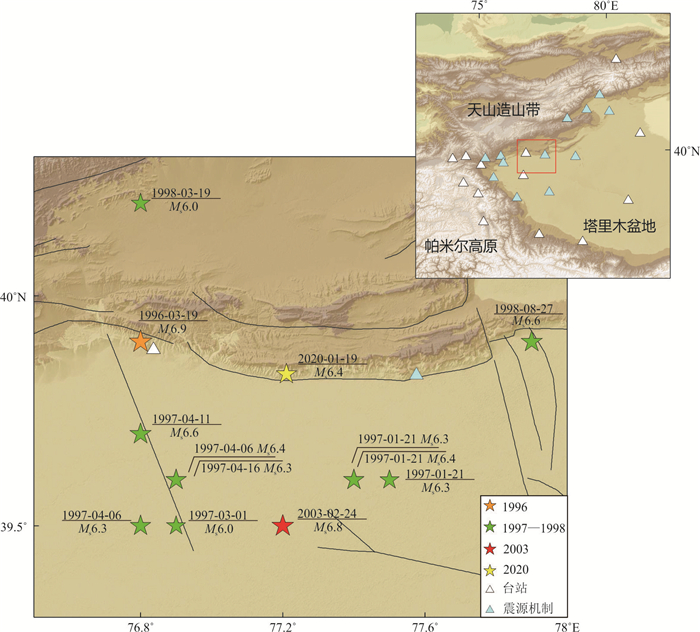
 下载:
下载:
